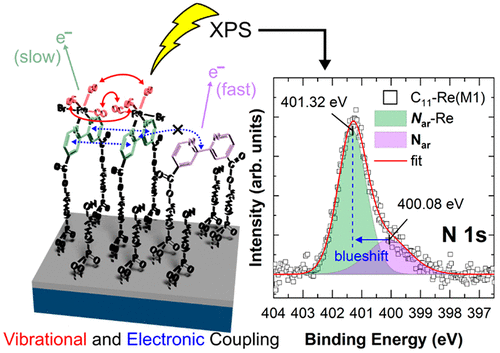当前位置:
X-MOL 学术
›
J. Am. Chem. Soc.
›
论文详情
Our official English website, www.x-mol.net, welcomes your
feedback! (Note: you will need to create a separate account there.)
Modular Assembly of Vibrationally and Electronically Coupled Rhenium Bipyridine Carbonyl Complexes on Silicon
Journal of the American Chemical Society ( IF 14.4 ) Pub Date : 2021-11-12 , DOI: 10.1021/jacs.1c09061 Johannes D Bartl 1, 2 , Christopher Thomas 2 , Alex Henning 1 , Martina F Ober 3, 4 , Gökcen Savasci 5, 6, 7 , Bahar Yazdanshenas 1 , Peter S Deimel 8 , Elena Magnano 9, 10 , Federica Bondino 9 , Patrick Zeller 11 , Luca Gregoratti 11 , Matteo Amati 11 , Claudia Paulus 1 , Francesco Allegretti 8 , Anna Cattani-Scholz 1, 4 , Johannes V Barth 8 , Christian Ochsenfeld 5, 6, 7 , Bert Nickel 3, 4 , Ian D Sharp 1 , Martin Stutzmann 1 , Bernhard Rieger 2
Journal of the American Chemical Society ( IF 14.4 ) Pub Date : 2021-11-12 , DOI: 10.1021/jacs.1c09061 Johannes D Bartl 1, 2 , Christopher Thomas 2 , Alex Henning 1 , Martina F Ober 3, 4 , Gökcen Savasci 5, 6, 7 , Bahar Yazdanshenas 1 , Peter S Deimel 8 , Elena Magnano 9, 10 , Federica Bondino 9 , Patrick Zeller 11 , Luca Gregoratti 11 , Matteo Amati 11 , Claudia Paulus 1 , Francesco Allegretti 8 , Anna Cattani-Scholz 1, 4 , Johannes V Barth 8 , Christian Ochsenfeld 5, 6, 7 , Bert Nickel 3, 4 , Ian D Sharp 1 , Martin Stutzmann 1 , Bernhard Rieger 2
Affiliation

|
Hybrid inorganic/organic heterointerfaces are promising systems for next-generation photocatalytic, photovoltaic, and chemical-sensing applications. Their performance relies strongly on the development of robust and reliable surface passivation and functionalization protocols with (sub)molecular control. The structure, stability, and chemistry of the semiconductor surface determine the functionality of the hybrid assembly. Generally, these modification schemes have to be laboriously developed to satisfy the specific chemical demands of the semiconductor surface. The implementation of a chemically independent, yet highly selective, standardized surface functionalization scheme, compatible with nanoelectronic device fabrication, is of utmost technological relevance. Here, we introduce a modular surface assembly (MSA) approach that allows the covalent anchoring of molecular transition-metal complexes with sub-nanometer precision on any solid material by combining atomic layer deposition (ALD) and selectively self-assembled monolayers of phosphonic acids. ALD, as an essential tool in semiconductor device fabrication, is used to grow conformal aluminum oxide activation coatings, down to sub-nanometer thicknesses, on silicon surfaces to enable a selective step-by-step layer assembly of rhenium(I) bipyridine tricarbonyl molecular complexes. The modular surface assembly of molecular complexes generates precisely structured spatial ensembles with strong intermolecular vibrational and electronic coupling, as demonstrated by infrared spectroscopy, photoluminescence, and X-ray photoelectron spectroscopy analysis. The structure of the MSA can be chosen to avoid electronic interactions with the semiconductor substrate to exclusively investigate the electronic interactions between the surface-immobilized molecular complexes.
中文翻译:

硅上振动和电子耦合铼联吡啶羰基配合物的模块化组装
混合无机/有机异质界面是下一代光催化、光伏和化学传感应用的有前途的系统。它们的性能在很大程度上依赖于具有(亚)分子控制的稳健可靠的表面钝化和功能化协议的开发。半导体表面的结构、稳定性和化学性质决定了混合组件的功能。通常,必须费力地开发这些改性方案以满足半导体表面的特定化学要求。与纳米电子器件制造兼容的化学独立但高度选择性的标准化表面功能化方案的实施具有最大的技术相关性。这里,我们引入了一种模块化表面组装 (MSA) 方法,通过将原子层沉积 (ALD) 和选择性自组装单层膦酸相结合,可以将分子过渡金属配合物以亚纳米精度共价锚定在任何固体材料上。ALD 作为半导体器件制造中的重要工具,用于在硅表面上生长共形氧化铝活化涂层,直至亚纳米厚度,以实现铼 (I) 联吡啶三羰基分子的选择性逐步层组装复合体。正如红外光谱、光致发光和 X 射线光电子能谱分析所证明的那样,分子复合物的模块化表面组装产生具有强分子间振动和电子耦合的精确结构的空间集合。
更新日期:2021-11-24
中文翻译:

硅上振动和电子耦合铼联吡啶羰基配合物的模块化组装
混合无机/有机异质界面是下一代光催化、光伏和化学传感应用的有前途的系统。它们的性能在很大程度上依赖于具有(亚)分子控制的稳健可靠的表面钝化和功能化协议的开发。半导体表面的结构、稳定性和化学性质决定了混合组件的功能。通常,必须费力地开发这些改性方案以满足半导体表面的特定化学要求。与纳米电子器件制造兼容的化学独立但高度选择性的标准化表面功能化方案的实施具有最大的技术相关性。这里,我们引入了一种模块化表面组装 (MSA) 方法,通过将原子层沉积 (ALD) 和选择性自组装单层膦酸相结合,可以将分子过渡金属配合物以亚纳米精度共价锚定在任何固体材料上。ALD 作为半导体器件制造中的重要工具,用于在硅表面上生长共形氧化铝活化涂层,直至亚纳米厚度,以实现铼 (I) 联吡啶三羰基分子的选择性逐步层组装复合体。正如红外光谱、光致发光和 X 射线光电子能谱分析所证明的那样,分子复合物的模块化表面组装产生具有强分子间振动和电子耦合的精确结构的空间集合。











































 京公网安备 11010802027423号
京公网安备 11010802027423号